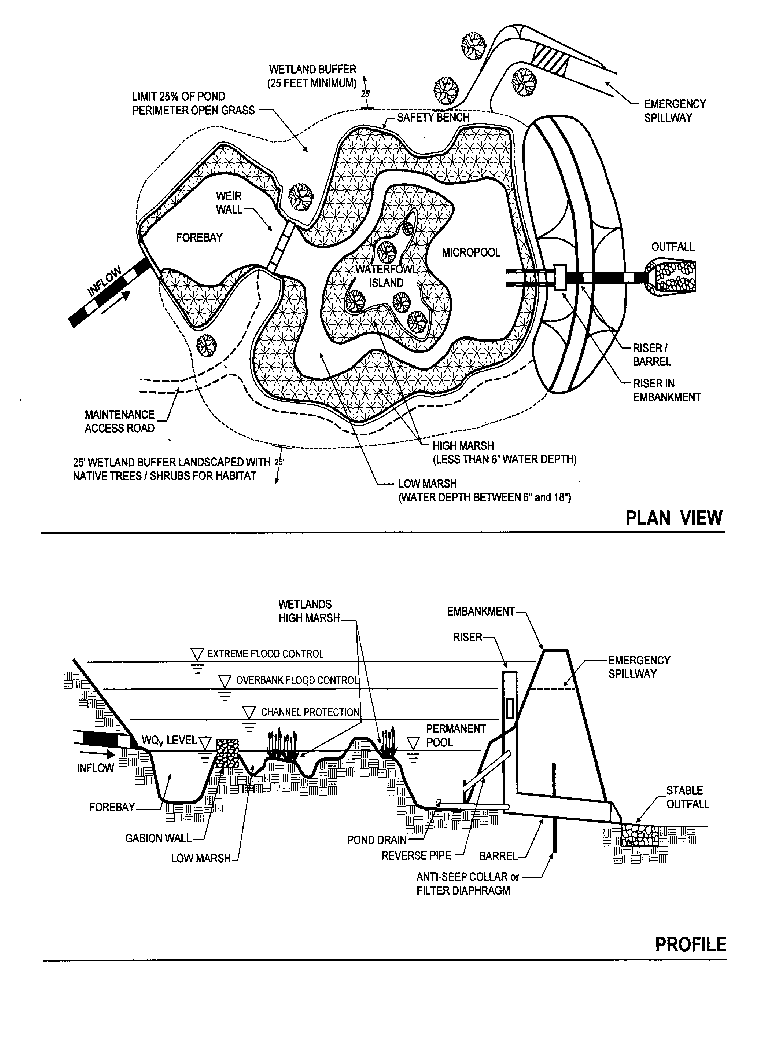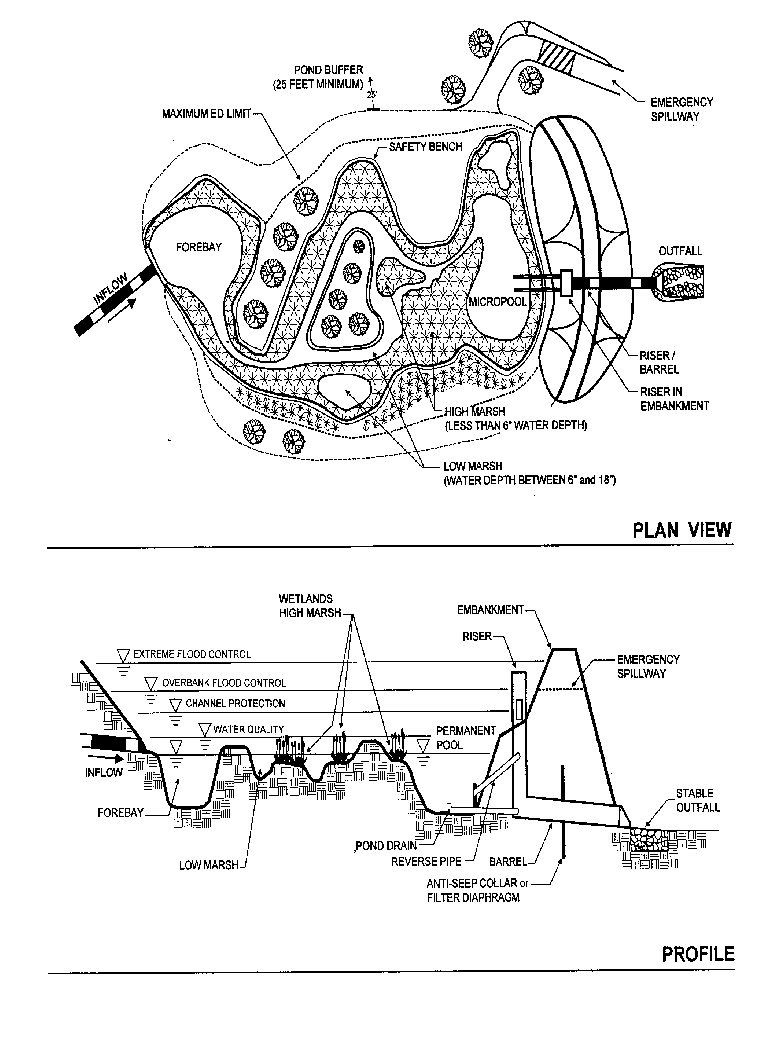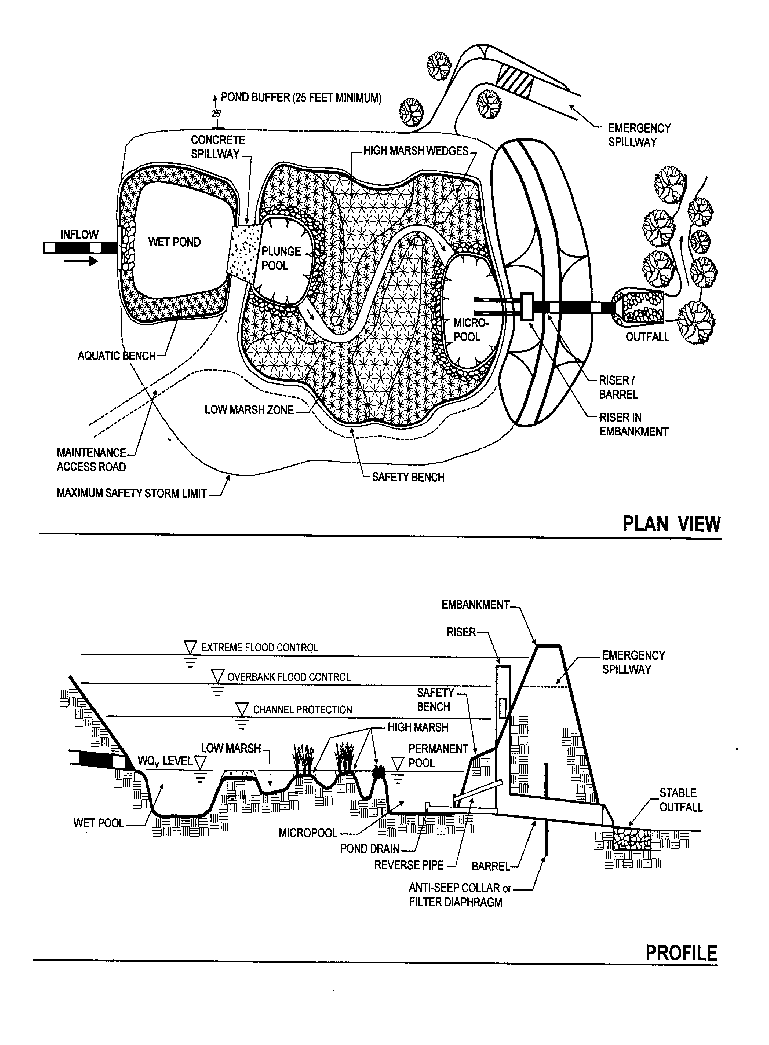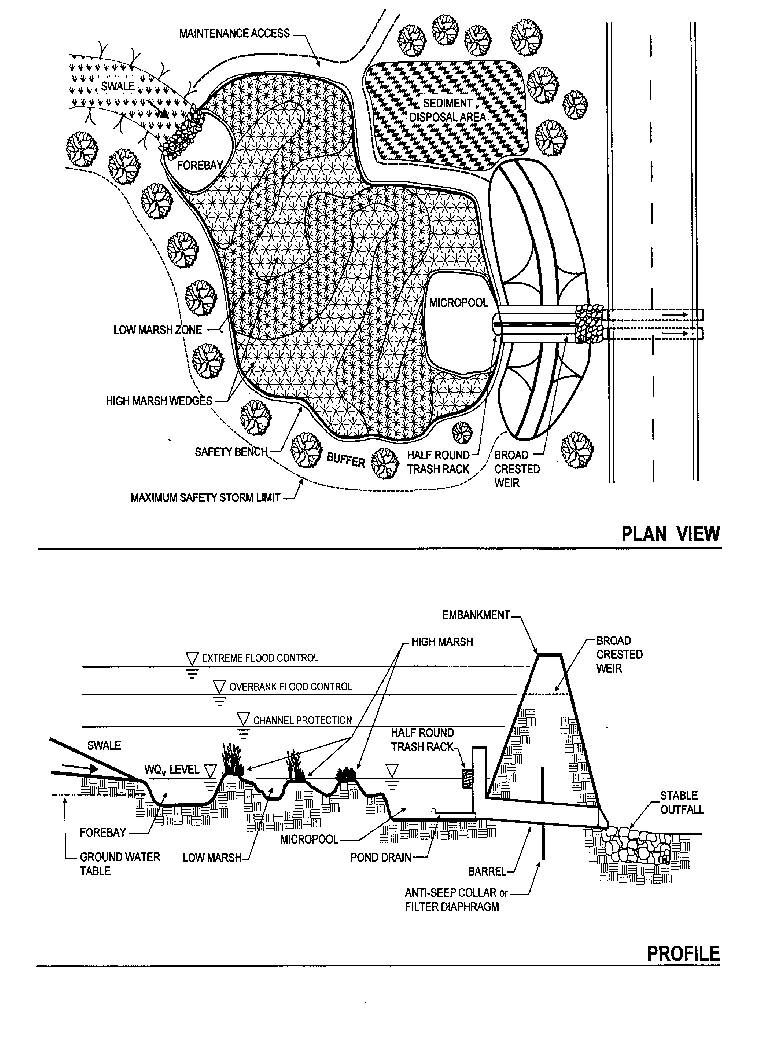Performance Criteria: Wetlands
Stormwater wetlands are practices that create shallow marsh areas to treat urban stormwater and often incorporate small permanent pools and/or extended detention storage to achieve the full WQv. Design variants include:
The section presents criteria for:
A summary of the design criteria is provided in Table 1. The table separates required or minimum design elements from design criteria that would act primarily as guidance.
![]() NOTE:
ALL OF THE POND CRITERIA PRESENTED IN PERFORMANCE CRITERIA - PONDS ALSO
APPLY TO THE DESIGN OF STORMWATER WETLANDS. ADDITIONAL CRITERIA THAT GOVERN
THE GEOMETRY AND ESTABLISHMENT OF CREATED WETLANDS ARE PRESENTED IN THIS SECTION.
NOTE:
ALL OF THE POND CRITERIA PRESENTED IN PERFORMANCE CRITERIA - PONDS ALSO
APPLY TO THE DESIGN OF STORMWATER WETLANDS. ADDITIONAL CRITERIA THAT GOVERN
THE GEOMETRY AND ESTABLISHMENT OF CREATED WETLANDS ARE PRESENTED IN THIS SECTION.
|
Table
1. Design Criteria: Wetlands
|
|
| Required Elements | Guidance |
| Feasibility | |
|
|
| Conveyance | |
| Minimum flow path | Microtopography |
| Pretreatment | |
|
|
| Treatment | |
|
|
| Landscaping | |
|
|
| Maintenance | |
|
|
![]() Please
note that judgement is needed to separate minimum design elements from guidance.
When crafting a local or state design manual, the jurisdiction will need to
go through a process involving stakeholders to select which design elements
are necessary in all cases.
Please
note that judgement is needed to separate minimum design elements from guidance.
When crafting a local or state design manual, the jurisdiction will need to
go through a process involving stakeholders to select which design elements
are necessary in all cases.




Wetland Feasibility Criteria
A water balance should be performed to demonstrate that a stormwater wetland can withstand a significant drought at summer evaporation rates without completely drawing down.
![]() This
requirement is critical in arid or semi-arid regions. In general, wetlands are
infeasible in these regions unless a supplemental water source can be identified.
This
requirement is critical in arid or semi-arid regions. In general, wetlands are
infeasible in these regions unless a supplemental water source can be identified.
Stormwater wetlands should not be located within existing jurisdictional wetlands. In some isolated cases, a permit may be granted to convert an existing degraded wetland in the context of local watershed restoration efforts.
![]() While
the strictness of state regulations varies, it is typically not a trivial process
to receive approval for any construction within jurisdictional wetlands.
While
the strictness of state regulations varies, it is typically not a trivial process
to receive approval for any construction within jurisdictional wetlands.
Wetland Conveyance Criteria
Flowpaths from the inflow points to the outflow points of stormwater wetlands shall be maximized. A minimum flowpath of 2:1 (length to relative width) should be provided across the stormwater wetland. This path may be achieved by constructing internal berms (e.g., high marsh wedges or rock filter cells).
![]() A
community may choose a different specific value for the specific length to width
ratio. The number provide here serves as guidance to manual developers.
A
community may choose a different specific value for the specific length to width
ratio. The number provide here serves as guidance to manual developers.
Microtopography is
encouraged to enhance wetland diversity.
Wetland Pretreatment Criteria
Sediment regulation is critical to sustain stormwater wetlands. Consequently, a forebay should be located at the inlet, and a micropool should be located at the outlet. For forebay design criteria, consult Performance Criteria - Ponds.
A micropool three to six feet deep should be used to protect the low flow pipe from clogging and prevent sediment resuspension.
Wetland Treatment Criteria
The surface area of the entire stormwater wetland should be at least one percent of the contributing drainage area (1.5% for shallow marsh design).
![]() This
value may vary regionally. In particular, design guidance for arid climates
may allow a smaller ratio in order to increase the amount of water supply to
the wetland, while maintaining a permanent pool.
This
value may vary regionally. In particular, design guidance for arid climates
may allow a smaller ratio in order to increase the amount of water supply to
the wetland, while maintaining a permanent pool.
At least 25% of the WQv should be in deepwater zones with a depth greater than four feet. The forebay and micropool may meet this criteria. In addition, the deepwater zones serve to keep mosquito populations in check by providing habitat for fish and other pond life that prey on mosquito larvae.
A minimum of 35% of the total surface area can have a depth of six inches or less, and at least 65% of the total surface area shall be shallower than 18 inches.
![]() While
the specific numbers may be debated, it is critical to establish some limits
on the area in deep and shallow zones, to encourage some minimum depth variability,
thus enhancing diversity.
While
the specific numbers may be debated, it is critical to establish some limits
on the area in deep and shallow zones, to encourage some minimum depth variability,
thus enhancing diversity.
The bed of the wetland should be graded to create maximum internal flow path and microtopography.
If extended detention is utilized in a stormwater wetland, the WQv -ED volume should not comprise more than 50% of the total WQV, and its maximum water surface elevation should not extend more than three feet above the permanent pool.
![]() Available
data suggest that pond designs that rely entirely or primarily on detention
have significantly compromised pollutant removal, when compared to those that
incorporate a wet pool.
Available
data suggest that pond designs that rely entirely or primarily on detention
have significantly compromised pollutant removal, when compared to those that
incorporate a wet pool.
To promote greater
nitrogen removal, rock beds may be used as a medium for growth of wetland plants.
The rock should be one to three inches in diameter, placed up to the normal
pool elevation, and open to flow-through from either direction.
![]() One
design that is not incorporated in this guidance, but shows promise as a potential
practice is the "gravel-based wetland." For more information, consult the Center
for Watershed Protection's 1996 publication, "Design of Stormwater Filtering
Systems."
One
design that is not incorporated in this guidance, but shows promise as a potential
practice is the "gravel-based wetland." For more information, consult the Center
for Watershed Protection's 1996 publication, "Design of Stormwater Filtering
Systems."
Wetland Landscaping
Criteria
A landscaping plan should be provided that indicates the methods used to establish and maintain wetland coverage. Minimum elements of a plan include: delineation of pondscaping zones, selection of corresponding plant species, planting plan, sequence for preparing wetland bed (including soil amendments, if needed) and sources of plant material.
Structures such as fascines, coconut rolls, straw bales, or filter fence can be used to create shallow marsh cells in high energy areas of the stormwater wetland.
The landscaping plan should provide elements that promote greater wildlife and waterfowl use within the wetland and buffers.
A wetland plant buffer may extend 25 feet outward from the maximum water surface elevation, with an additional 15 foot setback to structures.
Wetland Establishment
The most common and reliable technique for establishing an emergent wetland community in a stormwater wetland is to transplant nursery stock obtained from local aquatic plant nurseries. The following guidance is suggested when transplants are used to establish a wetland.
Plant only during the transplanting window. Wetland plants need a full growing season to build root reserves needed to get through the winter. If at all possible, plants should be ordered at least three months in advance to ensure the availability of the desirable species.
![]() The
transplanting window varies between regions, and starts after the last spring
frost. In cold climates, this window of time is typically very short, making
early planning particularly important.
The
transplanting window varies between regions, and starts after the last spring
frost. In cold climates, this window of time is typically very short, making
early planning particularly important.
The optimal depth
requirements for several common species of emergent wetland plants are often
six inches or less.
To add diversity to the wetland, five to seven species of emergent wetland plants should be planted.
No more than half the wetland surface area needs to be planted. If the appropriate planting depths are achieved, the entire wetland should be colonized within three years.
The wetland area should be subdivided into separate planting zones of more or less constant depth.
One plant species should be planted within each flagged panting zone, based on approximate depth requirements.
Individual plants should be planted 18 inches on center in clumps.
Post-nursery care of wetland plants is very important in the interval between delivery of the plants and their subsequent planting, as they are prone to dessication. Stock should be frequently watered and shaded while on-site.
A wet hydroseed mix should be used to establish permanent vegetative cover in the buffer outside the permanent pool. For rapid germination, scarify the soil to � inch prior to hydroseeding. Alternatively, grass species can be used as a temporary cover for the wet species.
Because most stormwater wetlands are excavated to deep subsoils, they often lack the nutrients and organic matter needed to support vigorous growth of wetland plants. At these sites, three to six inches of topsoil or wetland mulch should be added to all depth zones in the wetland from one foot below the normal pool to six inches above. Wetland mulch is preferable to topsoil if it is available.
The stormwater wetland should be staked at the onset of the planting season. Depths in the wetland should be measured to the nearest inch to confirm original planting zones. At this time, it may be necessary to modify the pondscaping plan to reflect altered depths or the availability of wetland plant stock. Surveyed planting zones should be marked on an "as-built" or design plan, and located in the field using stakes or flags. The wetland drain should be fully opened at least three days prior to the planting dates (which should coincide with the delivery date for the wetland plant stock).
Wetland mulch is another technique to establish a wetland plant community which utilizes the seedbank of wetland soils to provide the propagules for marsh development. The majority of the seedbank is contained within the upper six inches of the donor wetland soils. The mulch is best collected at the end of the growing season. Best results are obtained when the mulch is spread three to six inches deep over the high marsh and semi-wet zones of the wetland (-6 inches to +6 inches relative to the normal pool).
![]() This
guidance is developed primarily for the Mid-Atlantic area. Please consult local
wetlands specialists when drafting a manual.
This
guidance is developed primarily for the Mid-Atlantic area. Please consult local
wetlands specialists when drafting a manual.
Another important
component of wetland establishment is species selection. A manual should incorporate
a list of appropriate plants. Local extension agencies, nurseries, and state
wetlands departments are excellent sources of information in this regard.
In some cases, the use of "volunteer wetlands," allowing cattails and phragmites to colonize may be appropriate. A good example is the use of wetlands to treat runoff from paved surfaces that are salted for snow management. It will typically be difficult to maintain diversity in this case, and volunteer wetlands may be a low cost alternative.
Donor soils for wetland mulch should not be removed from natural wetlands.
![]() There
are some exceptions to this rule. For example, wetland plants may in some cases
be removed from a site that is slated for development, and that has a wetland
mitigation plan in place.
There
are some exceptions to this rule. For example, wetland plants may in some cases
be removed from a site that is slated for development, and that has a wetland
mitigation plan in place.
Wetland Maintenance
Criteria
If a minimum coverage of 50% is not achieved in the planted wetland zones after the second growing season, a reinforcement planting will be required.
Stormwater wetlands that are separated from jurisdictional wetlands and regularly maintained are typically not regulated under appropriate State and federal laws.
![]() Please
consult your state agency regarding specific wetland regulations.
Please
consult your state agency regarding specific wetland regulations.